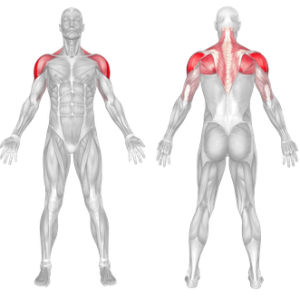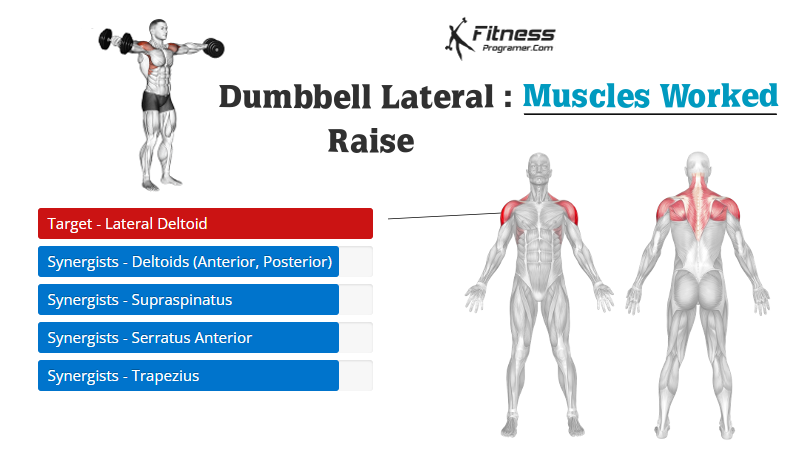Overview
The dumbbell lateral raise is a strength exercise where you lift dumbbells out to the sides until your arms are parallel to the floor. It mainly targets the side deltoids, with support from the trapezius and upper back muscles. Popular in bodybuilding and rehab routines, it helps build round shoulders and improves shoulder stability.
How to Perform Dumbbell Lateral Raise
Starting Position: Stand upright with feet shoulder-width apart, holding dumbbells at your sides with palms facing inward.
Brace and Align: Engage your core muscles and slightly bend your knees to maintain stability.
Movement: Lift the dumbbells out to your sides, keeping a slight bend in your elbows and wrists straight. Raise the dumbbells until your arms reach shoulder level, parallel to the floor.
Controlled Return: Lower the weights slowly and smoothly back to the starting position while maintaining control and tension in your shoulders.
Repeat: Continue for the desired number of repetitions, typically 10–12 reps.
Tips for Proper Form:
Keep your core engaged and spine neutral throughout the movement.
Do not swing or use momentum; lift weights slowly and with controlled motion.
Keep elbows slightly bent to prevent joint strain.
Focus on lifting through your elbows rather than wrists to emphasize deltoid activation.
Common Mistakes:
Lifting Too Heavy: Choosing heavy weights often results in poor form and overuse of momentum, reducing effectiveness and increasing injury risk.
Raising Dumbbells Too High: Avoid lifting dumbbells higher than shoulder level to prevent unnecessary stress on shoulder joints.
Excessive Elbow Bend: Too much bend in elbows reduces the workload on shoulders and shifts tension elsewhere. Maintain a slight bend only.
Benefits of the Dumbbell Lateral Raise
Isolates the Lateral Deltoids: Directly targets the side shoulder muscles, contributing to broader, well-defined shoulders.
Enhances Shoulder Strength and Stability: Builds stabilizing muscles around the shoulder joint, helping prevent injury and improving overall shoulder function.
Improves Shoulder Aesthetics: Regular practice enhances muscular symmetry and definition, achieving a balanced upper-body appearance.
Supports Better Posture: Strengthening shoulders and upper-back muscles contributes to improved posture and alignment, reducing risks of slouching and related discomfort.
Versatile and Accessible Exercise: Can easily be performed at home or gym, requiring minimal equipment (just dumbbells), making it highly adaptable for various training environments.
How to Incorporate Into Your Routine
For Beginners: Perform 2–3 sets of 10–12 reps using light dumbbells to establish correct form and gradually increase strength.
For Hypertrophy (Muscle Growth): Do 3–4 sets of 8–12 reps with moderate weights, emphasizing a controlled tempo and maintaining muscle tension.
For Strength and Definition: Perform 4 sets of 6–8 reps with heavier dumbbells, resting 1–2 minutes between sets.
For Rehabilitation: Incorporate 2–3 sets of 10–15 reps with very light weights, focusing on smooth movement patterns and controlled shoulder engagement.
For Functional Training: Include as part of upper-body circuits or supersets with complementary movements, such as front raises or shoulder presses.
Lateral Raise Muscles Worked

Frequently Asked Questions
How often should I do dumbbell lateral raises?
Typically, 1–2 times per week is sufficient for strength and hypertrophy when combined with other shoulder exercises.
Can dumbbell lateral raises cause shoulder pain?
With correct form and appropriate weight, lateral raises are safe. Pain usually results from improper technique or overly heavy weights.
Are lateral raises effective without heavy weights?
Yes, lighter weights with controlled movements are highly effective for isolating and strengthening the lateral deltoids.
Should I keep my elbows straight or bent during lateral raises?
Maintain a slight bend in your elbows (around 10–15 degrees) to protect your joints and maximize deltoid activation.
What’s the difference between dumbbell and cable lateral raises?
Dumbbell lateral raises provide variable tension throughout the range of motion, while cable lateral raises maintain consistent resistance from start to finish. Both effectively target the lateral deltoids.


